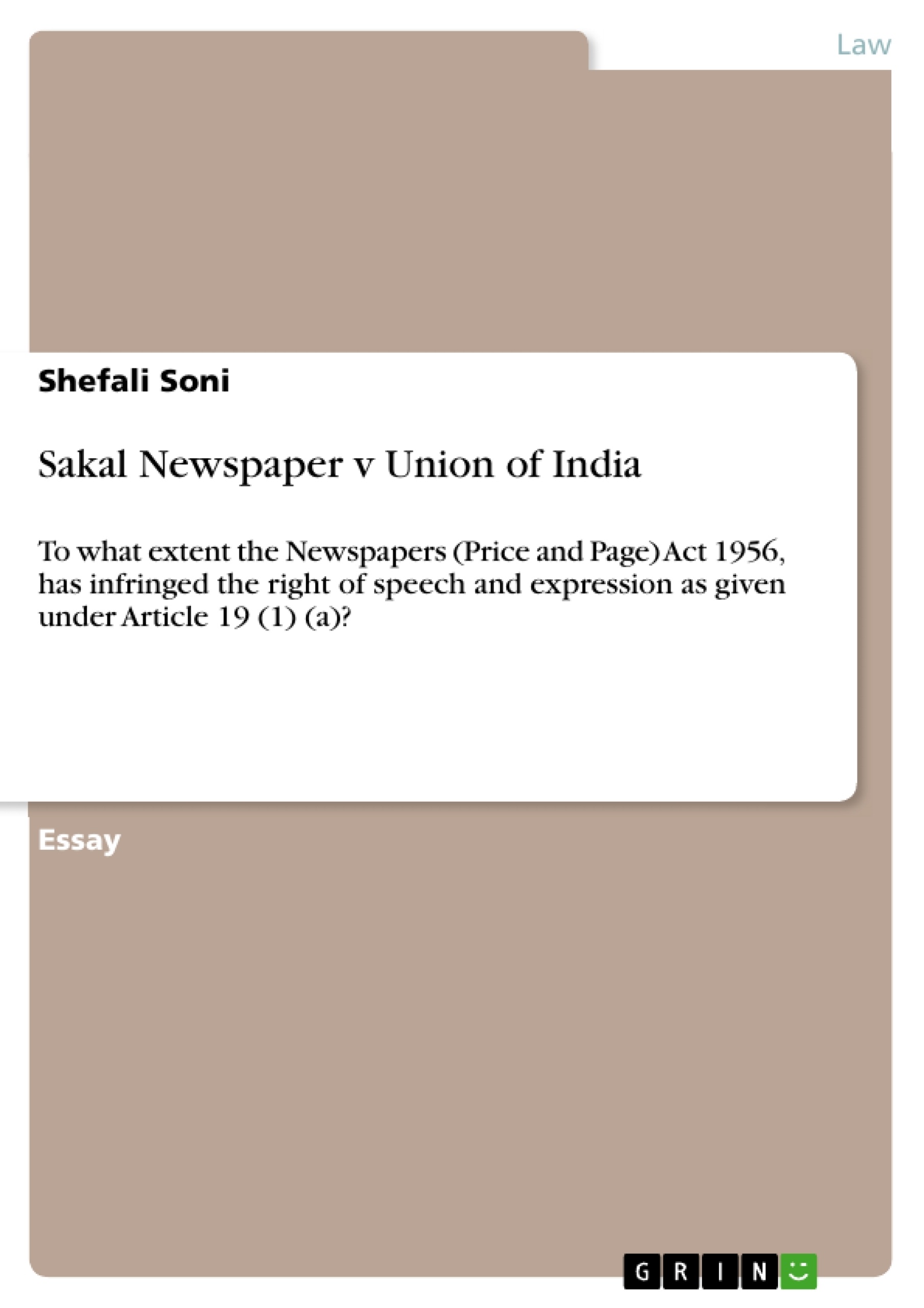The purpose of the paper is to identify that, does actually the Newspaper Act,1956 is infringing the rights of Petitioner or not?
Scope of problem is limited under Article 19 of Constitution of India only and this paper mainly focuses about the Right of press which was infringed in the present case by Government of India.
Objective of the Paper:
1. To Analyze the concept of Speech and Expression;
2. To interpret the provisions of the Newspaper Act,1956;
3. To evaluate the Role of press under circulation and publication
Table of Contents
- Statement of Purpose
- Question of Law/Research Question
- Scope of Problem
- Objective of the Paper
- Research Questions
- Literature Review
- Judgment of Sakal Newspaper v Union of India
- Suggestion
- Bibliography
Objectives and Key Themes
The objective of this paper is to analyze whether the Newspapers (Price and Page) Act, 1956 infringes upon the petitioner's rights. It examines the extent to which this Act restricts freedom of speech and expression under Article 19(1)(a) of the Indian Constitution.
- Freedom of speech and expression under Article 19(1)(a)
- Analysis of the Newspapers (Price and Page) Act, 1956
- The role of the press in circulation and publication
- The impact of the Act on the freedom of the press
- The concept of "commercial speech" and its relationship to freedom of expression
Chapter Summaries
Statement of Purpose: This section introduces the paper's main goal: determining whether the Newspapers (Price and Page) Act of 1956 violates the petitioner's rights. It sets the stage for the subsequent analysis of the Act's impact on freedom of speech and expression.
Question of Law/Research Question: This chapter lays out the central questions driving the research. It directly addresses the extent to which the 1956 Act infringes upon Article 19(1)(a) of the Indian Constitution, concerning freedom of speech and expression. It also explores the scope of freedom of speech and expression, establishing the framework for analyzing the case.
Scope of Problem: This section defines the limitations of the research, focusing solely on Article 19 of the Indian Constitution and its implications for the freedom of the press in the context of the Sakal Newspaper case. It clarifies the specific area of constitutional law being examined.
Objective of the Paper: This chapter outlines the paper's key objectives: analyzing the concept of freedom of speech and expression; interpreting the provisions of the Newspaper Act, 1956; and evaluating the role of the press in circulation and publication. These objectives provide a clear roadmap for the subsequent analysis.
Research Questions: This section reiterates the main research questions, providing a detailed breakdown of the central problem. It focuses on the impact of the Newspapers (Price and Page) Act, 1956, on the right to freedom of speech and expression, setting the stage for a deeper investigation.
Literature Review: (While the provided text mentions a Literature Review, its content isn't included. A summary would require the content of that section.)
Judgment of Sakal Newspaper v Union of India: (Summary of the actual Judgement would go here. The provided text only contains page numbers)
Keywords
Freedom of speech and expression, Article 19(1)(a), Newspapers (Price and Page) Act, 1956, Sakal Newspaper, Indian Constitution, freedom of the press, commercial speech, right to know.
Frequently Asked Questions: Analysis of the Newspapers (Price and Page) Act, 1956 and Freedom of Speech
What is the main objective of this paper?
The paper analyzes whether the Newspapers (Price and Page) Act, 1956 infringes upon the petitioner's rights, specifically examining the Act's restriction on freedom of speech and expression under Article 19(1)(a) of the Indian Constitution.
What are the key themes explored in this paper?
Key themes include freedom of speech and expression under Article 19(1)(a), analysis of the Newspapers (Price and Page) Act, 1956, the role of the press in circulation and publication, the impact of the Act on press freedom, and the concept of "commercial speech" and its relation to freedom of expression.
What is the scope of the research?
The research focuses solely on Article 19 of the Indian Constitution and its implications for press freedom within the context of the Sakal Newspaper v Union of India case. It does not extend beyond this specific area of constitutional law.
What are the main research questions addressed?
The central questions concern the extent to which the 1956 Act infringes upon Article 19(1)(a) and explores the scope of freedom of speech and expression in relation to the Act's impact on the press.
What does the "Statement of Purpose" section cover?
This section introduces the paper's goal: determining if the 1956 Act violates the petitioner's rights, setting the stage for analyzing the Act's impact on freedom of speech and expression.
What is covered in the "Question of Law/Research Question" section?
This section lays out the central research questions, directly addressing the extent to which the 1956 Act infringes upon Article 19(1)(a) and explores the scope of freedom of speech and expression.
What is included in the "Objective of the Paper" section?
This section outlines the paper's key objectives: analyzing freedom of speech and expression; interpreting the provisions of the Newspaper Act, 1956; and evaluating the press's role in circulation and publication.
What does the "Literature Review" section cover (as per the preview)?
The preview does not provide the content of the Literature Review section; only its presence is mentioned.
What is the significance of the Sakal Newspaper v Union of India case?
This case is central to the paper's analysis, providing the real-world context for examining the impact of the Newspapers (Price and Page) Act, 1956, on freedom of speech and expression.
What are the keywords associated with this paper?
Keywords include: Freedom of speech and expression, Article 19(1)(a), Newspapers (Price and Page) Act, 1956, Sakal Newspaper, Indian Constitution, freedom of the press, commercial speech, and right to know.
What is the structure of the Table of Contents?
The Table of Contents includes: Statement of Purpose, Question of Law/Research Question, Scope of Problem, Objective of the Paper, Research Questions, Literature Review, Judgment of Sakal Newspaper v Union of India, Suggestion, and Bibliography.
- Quote paper
- Shefali Soni (Author), 2019, Sakal Newspaper v Union of India, Munich, GRIN Verlag, https://www.grin.com/document/535530




